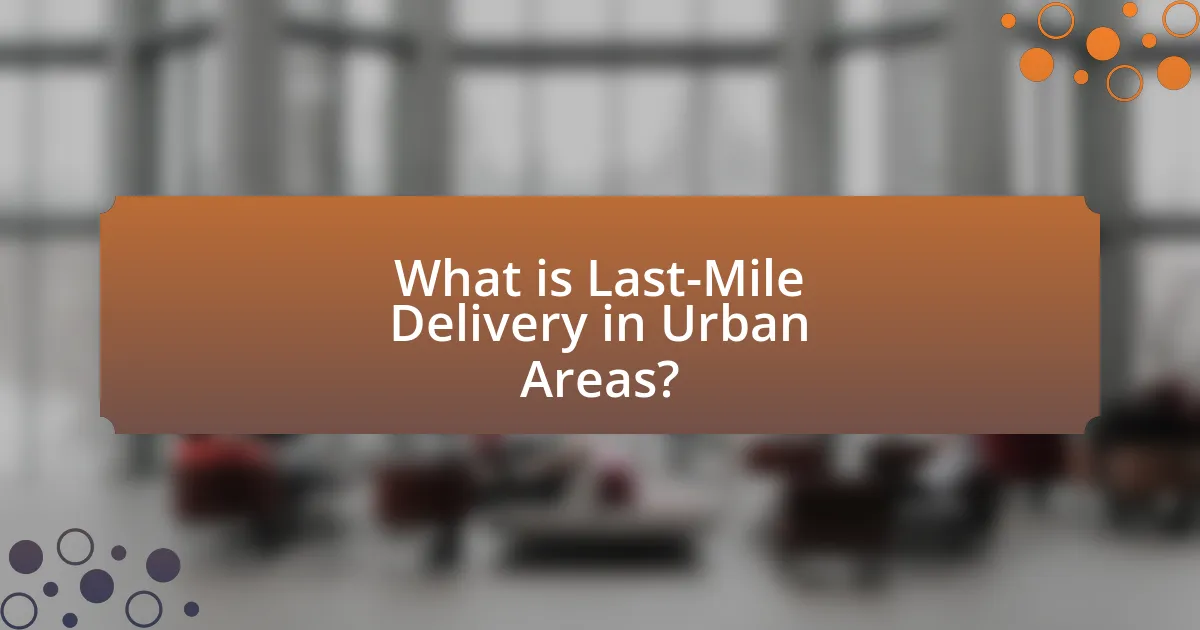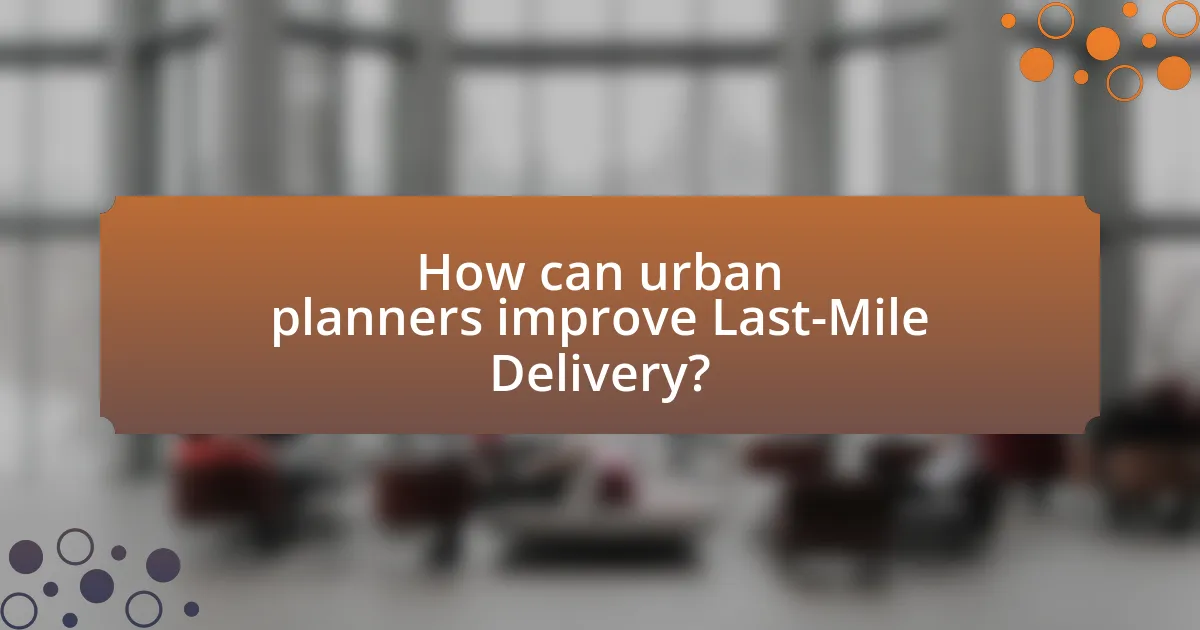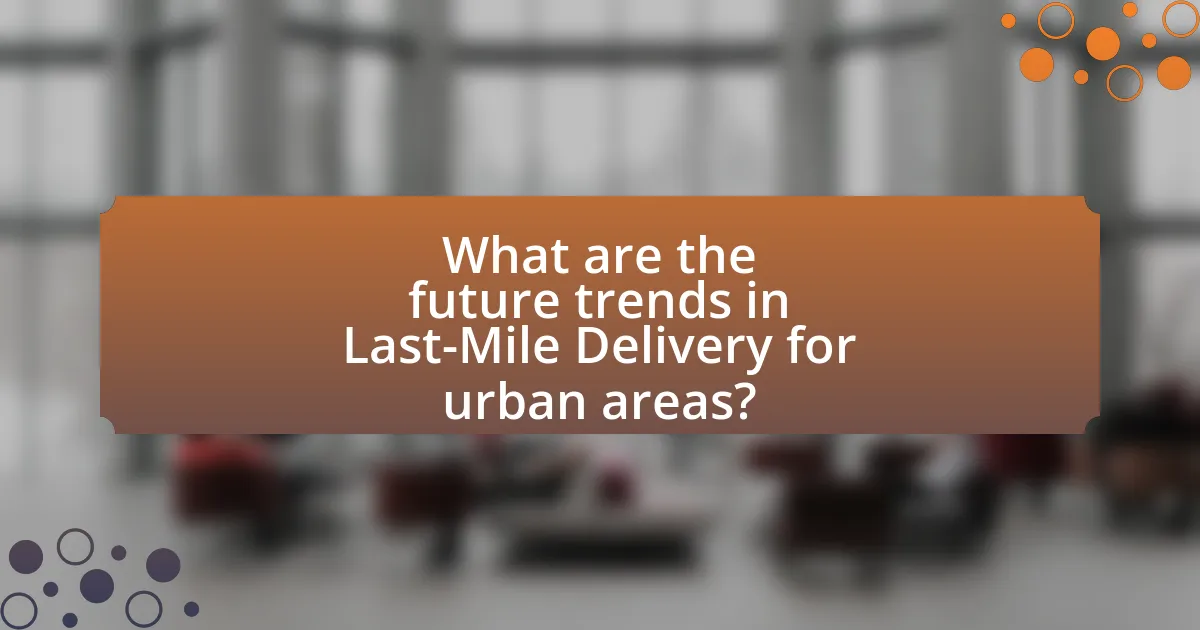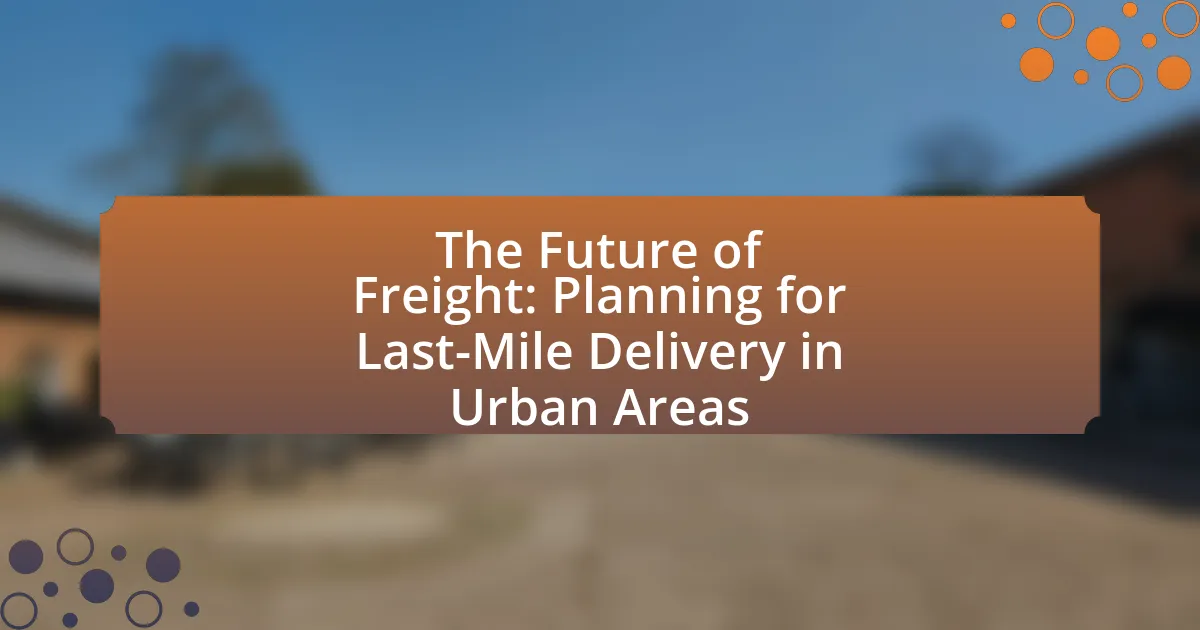The article focuses on the critical aspect of last-mile delivery in urban areas, which represents the final step in the logistics process where goods are transported from distribution centers to consumers. It highlights the unique challenges faced in urban environments, such as traffic congestion and regulatory restrictions, which significantly impact delivery efficiency and costs. Key components of effective last-mile delivery include logistics management, route optimization, and customer communication, while emerging technologies and sustainable practices are shaping future strategies. The article also discusses the importance of collaboration among stakeholders and the role of public policies in optimizing last-mile delivery systems.

What is Last-Mile Delivery in Urban Areas?
Last-mile delivery in urban areas refers to the final step of the logistics process where goods are transported from a distribution center to the end consumer’s location. This phase is crucial as it often accounts for a significant portion of the total shipping costs, typically ranging from 28% to 50% of the overall logistics expenses, according to the Council of Supply Chain Management Professionals. Efficient last-mile delivery is essential for meeting consumer expectations for fast and reliable service, especially in densely populated urban environments where traffic congestion and limited access can complicate deliveries.
How does Last-Mile Delivery differ from other freight processes?
Last-Mile Delivery differs from other freight processes primarily in its focus on the final leg of the delivery journey, which involves transporting goods from a distribution center to the end consumer. This stage is characterized by shorter distances, higher delivery frequency, and a greater emphasis on speed and customer satisfaction compared to other freight processes that typically handle larger volumes over longer distances. According to a report by McKinsey, last-mile delivery can account for up to 28% of the total delivery costs, highlighting its unique challenges and importance in the logistics chain.
What are the key components of Last-Mile Delivery?
The key components of Last-Mile Delivery include logistics management, route optimization, delivery technology, customer communication, and fleet management. Logistics management ensures efficient coordination of resources and processes to facilitate timely deliveries. Route optimization utilizes algorithms to determine the most efficient paths for delivery vehicles, reducing travel time and costs. Delivery technology encompasses tools such as mobile apps and tracking systems that enhance visibility and efficiency in the delivery process. Customer communication involves providing real-time updates and support to enhance customer satisfaction. Fleet management focuses on maintaining and optimizing the vehicles used for deliveries, ensuring reliability and efficiency. These components collectively contribute to the effectiveness and efficiency of Last-Mile Delivery in urban areas.
Why is Last-Mile Delivery critical in urban logistics?
Last-mile delivery is critical in urban logistics because it directly impacts customer satisfaction and operational efficiency. This segment of the supply chain accounts for a significant portion of total delivery costs, often estimated at 28% to 30% of the overall logistics expenses, according to the 2020 Logistics Management report. Efficient last-mile delivery ensures timely and accurate deliveries, which are essential for meeting the increasing consumer demand for fast shipping options. Furthermore, urban areas present unique challenges such as traffic congestion and limited access, making effective last-mile strategies vital for minimizing delays and optimizing resource use.
What challenges does Last-Mile Delivery face in urban environments?
Last-mile delivery faces significant challenges in urban environments, primarily due to congestion, limited access, and regulatory restrictions. Urban areas often experience high traffic volumes, which can delay deliveries and increase operational costs. For instance, a study by the European Commission found that urban freight transport contributes to 30% of road congestion, impacting delivery efficiency. Additionally, many cities impose restrictions on vehicle access in certain zones, further complicating delivery logistics. These factors necessitate innovative solutions to optimize delivery routes and improve overall efficiency in urban last-mile logistics.
How do traffic congestion and urban infrastructure impact Last-Mile Delivery?
Traffic congestion and urban infrastructure significantly hinder Last-Mile Delivery by increasing delivery times and operational costs. Congested roadways lead to delays, which can extend delivery windows and reduce overall efficiency. For instance, a study by the Texas A&M Transportation Institute found that traffic congestion costs the U.S. economy approximately $166 billion annually, impacting logistics and delivery services. Additionally, inadequate urban infrastructure, such as limited loading zones and poor road conditions, complicates access for delivery vehicles, further exacerbating delays and increasing the likelihood of missed delivery windows. These factors collectively challenge the effectiveness of Last-Mile Delivery in urban environments.
What role does customer demand play in shaping Last-Mile Delivery strategies?
Customer demand is a critical factor in shaping Last-Mile Delivery strategies, as it directly influences service offerings, delivery speed, and operational efficiency. High customer expectations for fast and reliable delivery compel logistics providers to innovate and optimize their last-mile solutions. For instance, a survey by McKinsey & Company found that 75% of consumers expect same-day or next-day delivery, prompting companies to adopt advanced technologies like route optimization and real-time tracking to meet these demands. Additionally, fluctuating consumer preferences for delivery options, such as contactless delivery or specific time slots, drive businesses to diversify their delivery methods, including partnerships with local couriers and the use of automated delivery vehicles. Thus, customer demand not only dictates the pace of innovation in last-mile logistics but also shapes the overall strategy and infrastructure of delivery networks.
What innovations are shaping the future of Last-Mile Delivery?
Innovations shaping the future of last-mile delivery include autonomous delivery vehicles, drones, and advanced route optimization algorithms. Autonomous delivery vehicles, such as those developed by companies like Nuro, are designed to transport goods without human drivers, enhancing efficiency and reducing labor costs. Drones, utilized by firms like Amazon, enable rapid delivery to remote or congested areas, significantly cutting down delivery times. Advanced route optimization algorithms leverage real-time data to improve delivery efficiency, reducing fuel consumption and operational costs. According to a report by McKinsey, implementing these technologies can lead to a 30% reduction in last-mile delivery costs, demonstrating their potential impact on the logistics industry.
How are technology and automation influencing Last-Mile Delivery?
Technology and automation are significantly enhancing last-mile delivery by increasing efficiency and reducing costs. Advanced routing algorithms optimize delivery paths, minimizing travel time and fuel consumption, which is crucial in urban areas where traffic congestion is prevalent. For instance, companies like Amazon utilize machine learning to predict demand and adjust delivery schedules accordingly, leading to faster service. Additionally, automation technologies such as drones and autonomous vehicles are being tested and implemented, which can operate without human intervention, further streamlining the delivery process. According to a report by McKinsey, automation in logistics could reduce last-mile delivery costs by up to 30% by 2030, demonstrating the transformative impact of these technologies on the industry.
What sustainable practices are being adopted in Last-Mile Delivery?
Sustainable practices in last-mile delivery include the use of electric vehicles, bicycle couriers, and optimized routing to reduce emissions and improve efficiency. Electric vehicles significantly lower greenhouse gas emissions compared to traditional delivery trucks, with studies showing that they can reduce emissions by up to 50% in urban areas. Bicycle couriers provide an eco-friendly alternative for short-distance deliveries, contributing to reduced traffic congestion and pollution. Additionally, companies are implementing advanced routing algorithms that minimize travel distances and time, further decreasing fuel consumption and emissions. These practices collectively enhance the sustainability of last-mile delivery operations.

How can urban planners improve Last-Mile Delivery?
Urban planners can improve last-mile delivery by optimizing urban infrastructure and implementing smart logistics solutions. By designing dedicated delivery zones and enhancing road networks, planners can reduce congestion and improve access for delivery vehicles. For instance, cities like Amsterdam have introduced designated loading and unloading areas, which have led to a 20% reduction in delivery times. Additionally, integrating technology such as real-time traffic data and route optimization software can further streamline delivery processes, as evidenced by companies like UPS, which reported a 10% increase in efficiency through advanced route planning. These strategies collectively enhance the effectiveness of last-mile delivery in urban environments.
What strategies can be implemented to enhance Last-Mile Delivery efficiency?
To enhance Last-Mile Delivery efficiency, companies can implement strategies such as optimizing delivery routes using advanced algorithms, employing local distribution centers, and utilizing technology for real-time tracking. Optimizing delivery routes reduces travel time and fuel consumption, which can lead to a 10-15% increase in efficiency, as evidenced by studies showing that route optimization software can significantly decrease delivery times. Local distribution centers allow for quicker access to urban areas, reducing the distance drivers must travel, while real-time tracking improves communication with customers, leading to higher satisfaction rates and fewer missed deliveries.
How can urban design facilitate better Last-Mile Delivery?
Urban design can facilitate better last-mile delivery by optimizing infrastructure for accessibility and efficiency. Well-planned urban layouts that include dedicated delivery zones, strategically placed loading docks, and pedestrian-friendly pathways reduce congestion and improve delivery times. For instance, cities like Amsterdam have implemented designated delivery windows and zones, which have led to a 20% reduction in delivery-related traffic. Additionally, integrating technology such as smart traffic signals and real-time data analytics can enhance route planning for delivery vehicles, further streamlining the process. These design elements collectively contribute to a more efficient last-mile delivery system, benefiting both businesses and consumers.
What role do public policies play in optimizing Last-Mile Delivery?
Public policies play a crucial role in optimizing Last-Mile Delivery by establishing regulations that enhance efficiency, reduce congestion, and promote sustainability. For instance, policies that incentivize the use of electric vehicles and alternative delivery methods can lower emissions and improve air quality in urban areas. Additionally, zoning regulations that allow for designated delivery zones can streamline operations and minimize disruptions to traffic flow. Research from the Urban Institute indicates that cities implementing such policies have seen a 20% reduction in delivery-related congestion. These measures not only improve the logistics of Last-Mile Delivery but also contribute to a more sustainable urban environment.
How can collaboration between stakeholders improve Last-Mile Delivery?
Collaboration between stakeholders can significantly improve Last-Mile Delivery by enhancing efficiency, reducing costs, and increasing customer satisfaction. When logistics providers, retailers, local governments, and technology companies work together, they can share resources, optimize routes, and implement innovative solutions such as crowdshipping or smart lockers. For instance, a study by the Urban Freight Lab at the University of Washington found that collaborative delivery models can reduce delivery times by up to 30% and lower operational costs by 20%. This synergy allows for better data sharing, which leads to more accurate demand forecasting and inventory management, ultimately resulting in a more responsive and sustainable Last-Mile Delivery system.
What partnerships are essential for effective Last-Mile Delivery solutions?
Essential partnerships for effective Last-Mile Delivery solutions include collaborations with local logistics providers, technology firms, and urban planners. Local logistics providers enhance delivery efficiency through established networks and knowledge of regional traffic patterns. Technology firms contribute by offering advanced tracking systems and data analytics, which optimize route planning and improve customer experience. Urban planners play a crucial role by facilitating infrastructure development that supports delivery operations, such as designated loading zones and pedestrian-friendly pathways. These partnerships collectively enhance the speed, reliability, and sustainability of Last-Mile Delivery in urban areas.
How can technology foster collaboration among delivery services and urban planners?
Technology can foster collaboration among delivery services and urban planners by providing data-driven insights and real-time communication platforms. For instance, Geographic Information Systems (GIS) enable urban planners to visualize delivery routes and traffic patterns, allowing delivery services to optimize their logistics based on urban infrastructure. Additionally, platforms like cloud-based project management tools facilitate seamless communication between stakeholders, ensuring that delivery services align their operations with urban planning initiatives. Research indicates that cities utilizing smart logistics technologies can reduce delivery times by up to 30%, demonstrating the effectiveness of such collaborations in enhancing urban mobility and efficiency.

What are the future trends in Last-Mile Delivery for urban areas?
Future trends in last-mile delivery for urban areas include the increased use of electric vehicles, autonomous delivery systems, and smart logistics solutions. Electric vehicles are being adopted to reduce carbon emissions, with cities like Los Angeles aiming for a 100% electric fleet by 2035. Autonomous delivery systems, such as drones and robots, are being tested in various urban environments, with companies like Amazon and Google leading the way. Additionally, smart logistics solutions, including real-time tracking and data analytics, are enhancing efficiency and customer satisfaction, as evidenced by a 2021 study from McKinsey, which found that companies utilizing advanced analytics in logistics can improve delivery times by up to 20%.
How will consumer behavior influence Last-Mile Delivery in the future?
Consumer behavior will significantly influence Last-Mile Delivery in the future by driving demand for faster, more flexible delivery options. As consumers increasingly prioritize convenience and speed, companies will need to adapt their logistics strategies to meet these expectations. For instance, a survey by McKinsey & Company found that 75% of consumers are willing to pay extra for same-day delivery, indicating a strong preference for rapid fulfillment. Additionally, the rise of e-commerce has led to a greater emphasis on personalized delivery experiences, with consumers favoring options such as delivery time slots and location flexibility. This shift in consumer preferences will compel logistics providers to innovate and optimize their last-mile delivery solutions, integrating technology and data analytics to enhance efficiency and customer satisfaction.
What emerging technologies are expected to revolutionize Last-Mile Delivery?
Emerging technologies expected to revolutionize Last-Mile Delivery include autonomous delivery vehicles, drones, and advanced robotics. Autonomous delivery vehicles, such as self-driving vans, can optimize routes and reduce labor costs, while drones provide rapid delivery options, especially in congested urban areas. Advanced robotics, including delivery robots that navigate sidewalks and streets, enhance efficiency in urban environments. According to a report by McKinsey & Company, the adoption of these technologies could reduce delivery costs by up to 30% and significantly improve delivery times, demonstrating their potential impact on the logistics industry.
How will environmental concerns shape Last-Mile Delivery practices?
Environmental concerns will significantly shape Last-Mile Delivery practices by driving the adoption of sustainable logistics solutions. As urban areas face increasing pollution and congestion, companies are compelled to implement eco-friendly delivery methods, such as electric vehicles and cargo bikes, to reduce their carbon footprint. For instance, a study by the International Transport Forum indicates that transitioning to electric delivery vehicles can cut greenhouse gas emissions by up to 70% compared to traditional diesel trucks. Additionally, urban planning initiatives are increasingly prioritizing low-emission zones, which will further necessitate the use of cleaner delivery options. This shift not only addresses regulatory pressures but also aligns with consumer preferences for environmentally responsible practices, ultimately transforming the landscape of Last-Mile Delivery.
What best practices can businesses adopt for effective Last-Mile Delivery?
Businesses can adopt several best practices for effective Last-Mile Delivery, including optimizing delivery routes, utilizing technology for real-time tracking, and offering flexible delivery options. Optimizing delivery routes reduces travel time and costs, which is crucial in urban areas where traffic congestion can significantly impact efficiency. Implementing technology such as GPS and route optimization software enables businesses to monitor deliveries in real-time, improving transparency and customer satisfaction. Additionally, providing flexible delivery options, such as same-day delivery or scheduled delivery windows, caters to customer preferences and enhances the overall delivery experience. According to a study by McKinsey & Company, efficient Last-Mile Delivery can reduce costs by up to 30%, highlighting the importance of these practices in improving operational efficiency and customer satisfaction.
How can businesses leverage data analytics for Last-Mile Delivery optimization?
Businesses can leverage data analytics for Last-Mile Delivery optimization by analyzing customer demand patterns, route efficiency, and delivery performance metrics. By utilizing advanced analytics tools, companies can identify peak delivery times and optimize routes based on real-time traffic data, which can reduce delivery times by up to 30%. Additionally, predictive analytics can forecast demand fluctuations, allowing businesses to allocate resources more effectively and improve overall service levels. For instance, a study by McKinsey & Company found that companies employing data-driven decision-making in logistics can achieve a 10-15% reduction in operational costs.
What are the key performance indicators for measuring Last-Mile Delivery success?
Key performance indicators (KPIs) for measuring Last-Mile Delivery success include delivery time, delivery accuracy, customer satisfaction, cost per delivery, and order fulfillment rate. Delivery time measures the speed at which packages reach customers, with studies indicating that faster delivery times enhance customer satisfaction and loyalty. Delivery accuracy assesses the percentage of orders delivered correctly, which is crucial for maintaining trust; a report from the National Retail Federation shows that 98% accuracy can significantly boost repeat purchases. Customer satisfaction is often gauged through surveys and feedback, reflecting the overall experience of the delivery process. Cost per delivery evaluates the efficiency of the delivery operation, with lower costs indicating better performance; logistics companies aim for a cost reduction of 10-15% annually. Finally, the order fulfillment rate measures the percentage of orders successfully delivered on time, with a target of 95% or higher being standard in the industry. These KPIs collectively provide a comprehensive view of Last-Mile Delivery effectiveness.
